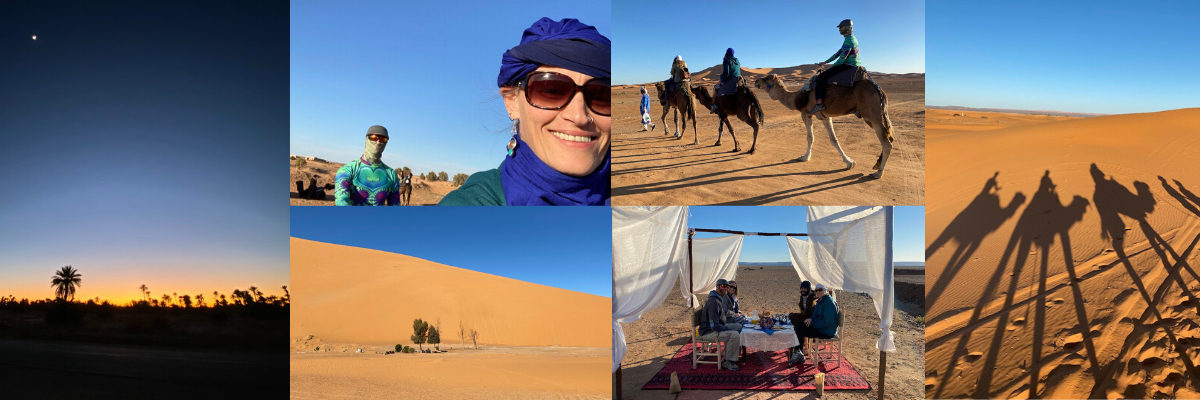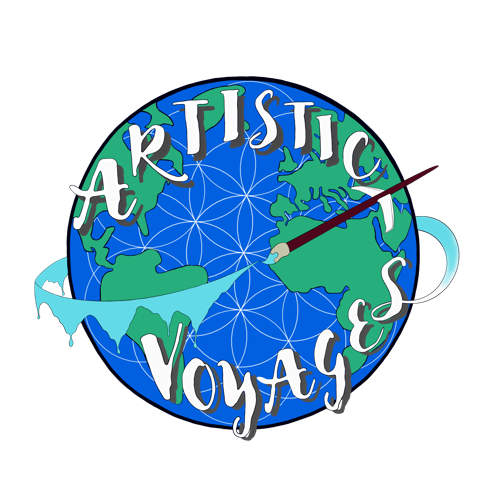
The Mighty SaHara

I’ve never been one to keep a bucket list. I have places in mind that I would like to visit, and things that I certainly want to see, but they have never been written down, only thought about and dreamt about. Sometimes, and unbeknownst to me, the Universe throws me into one of these magical places, and I manage to live out the most epic dream of that place, that I could possibly have ever conjured up.
I’m delighted to say that the Sahara Desert was one of those places.
From the moment we stepped foot from the vehicle in Er-Rissani, one of the far eastern towns lining the desert edge at the end of Morocco’s paved roads, I knew that THIS had been the Morocco that I was most wanting to see.
This had been the Morocco that my mind conjured up when I thought of the country prior to coming here. The dust covered streets, the rough around the edges kind of feel, the traditional way of living and the laid back way of life. Things move slowly in the desert. It seems as though there are no clocks and time just seemed to almost vanish while we were there.
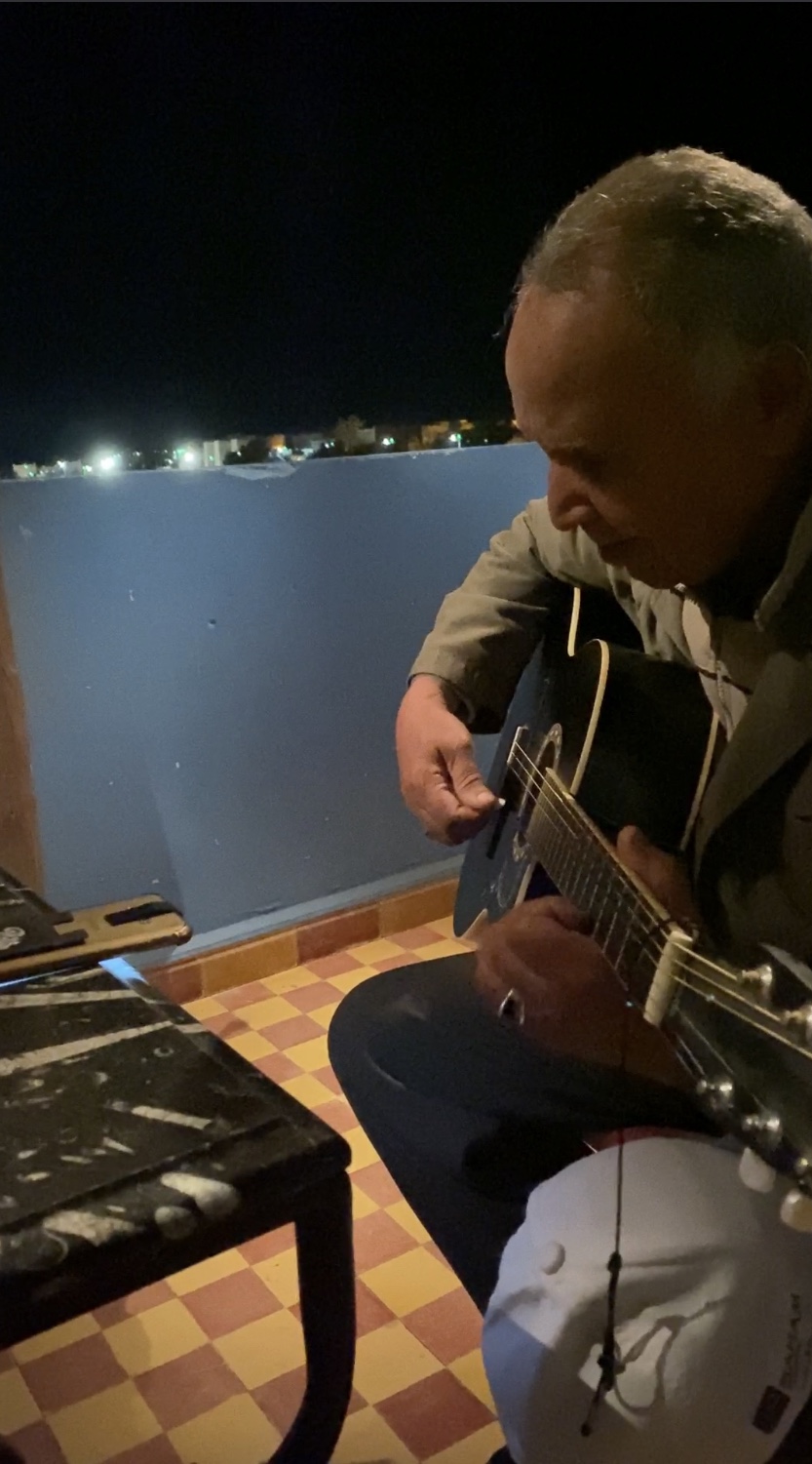
Our very basic hotel sat high above the central roundabout, just outside the walls of the main market in the city. From our terrace perch 4 floors up, we could sit and look out over the main market street and watch the world go by. Merchants tottered to and fro with their carts of whatever items they were trying to sell. Donkeys and wagons wandered back and forth, bikes scooted this way and that, and many groups of men could be found lining the sidewalks, enjoying their time at the coffee shops hanging out with their buddies.
It was a lot of hustle and bustle, but not too much. It seemed like just the right amount of business was happening, and the amount of people coming and going still left breathing room. Once inside the massive market complex, we explored different aisles and booths that were all built attached to one and other, creating a spider web complex of alleyways running in every direction.
We met a shoemaker who sits all day making and repairing shoes in his tiny shoe shop. I bought a brand new pair of handmade leather sandals for just $10. We visited the men that carve spoons, spatulas, bowls and many other eating utensils from some sort of soft local wood. They sit on the ground in their sawdust piles, whittling away on their craft.
Our first evening hanging out on the upper terrace of our hotel, brought us the most lovely and unassuming man that proceeded to sit at our table and start strumming his guitar. He played the softest and most genuine Moroccan music that we had ever heard. Grab a glass of wine and listen here!
In the far corner of the market sits the blacksmith who hammers away on his metal, making all sorts of hooks and tools and anything else that somebody requires him to make for them. The tailors have their own aisle, side by side offering basically the same services, rolls of fabric stacked to the ceiling, and machines humming away with the men hunched up behind them.
The natural pharmacy shop is the real gem of the market. We sat for half an hour or so while a handsome moroccan man (I swear they are ALL handsome here!) told us about many of the natural remedies that they had in the store, each one offering up some sort of cure for some particular malady. He even gave us all a makeup job, yes even the men!
A black eye liner of sorts that apparently helps to protect your eyes from the harsh desert sun, ‘natural sunglasses for the eyes’, we were told, was applied with much grace and style. The man applying it, of course, had some on as well, and I took note of his seductive look. In that moment, it dawned on me how it is that Moroccan men all seem to look so beautiful, and I realized that I somehow had always wondered if men that looked like him had in fact had any makeup on.
Many times these booths are owned by generations of families. Kids are simply brought up to take on the family business, and they take pride in keeping the family traditions going. Most everyone seems content in what they do, and they are happy to provide the best experience possible to you. In this place where there are few tourists, they have yet to learn that we can easily be taken advantage of. Or maybe they are just good people, and likely would never consider doing that anyways? At the root, Moroccans seem to be the most honest and genuine people that we have met.
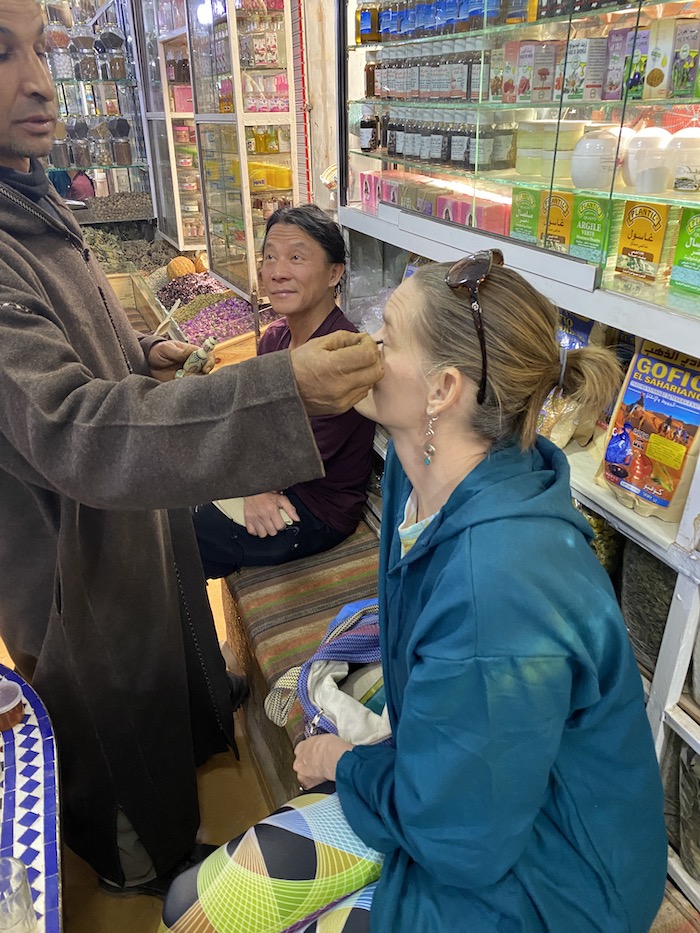

The animal market that only happens on Sundays, is something to behold. Huge corrals are organized to hold sheep in one, cows in another. Animals are tied to the fence or stakes in the ground to keep them from moving around. A very real look at a culture that still buys its meat live. Sometimes the animals are to be added to other herds, but I’m guessing that many times they are purchased for large celebrations, or sometimes for a whole neighbourhood to feast on.
We learned that this area of Morocco, specifically, was the largest trading area in the world at one time. Its strategic location made it accessible from Africa below, Europe above, and Asia to the east. People trekked from all corners of the globe to trade goods at this post. The most expensive item at the time? Salt.
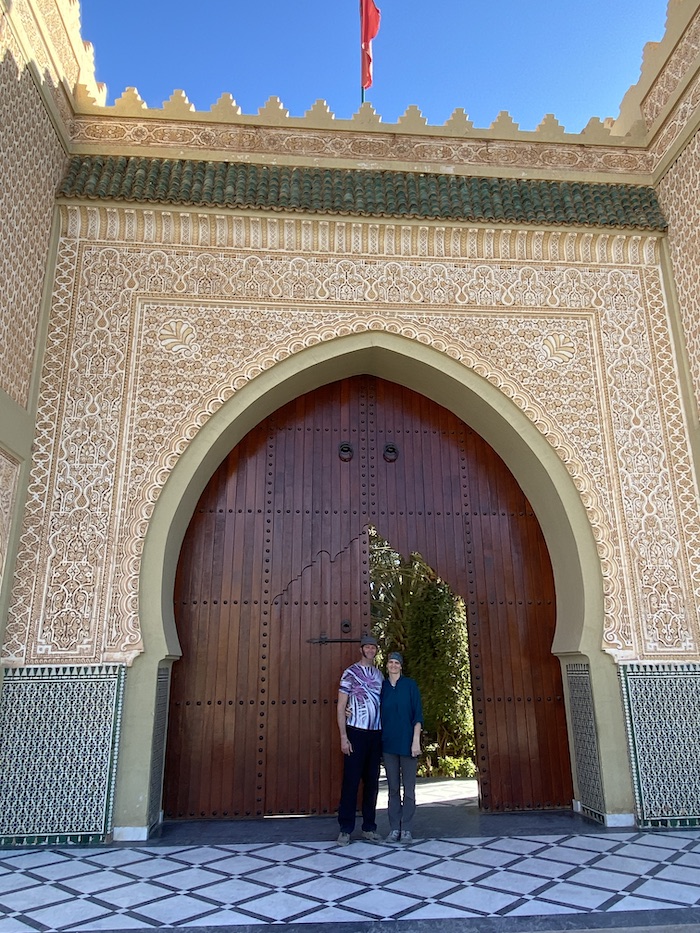
We visited many of the old walled cities, known as Kasbah’s, that surround Rissani. Built around 500 years ago, they housed huge families within their walls. Some of them now totally abandoned, others partially kept up and still lived in, yet more that are restored and kept fresh by the government for tourism.
We also visited the first Sultan palace that was built in the area. At one time, the richest man of the land lived in it with his many wives and children. Today, one old lady, a long distant family member of the once rich family, now left in the massive palace walls alone to fend for herself and her handful of children, barely eking out a living by allowing a scant number of tourists to visit her still stately home.
The intricacy and carved details, along with the tile work and craftsmanship of Moroccan architecture is stunning to behold!
Even today, buildings are being built to traditional standards, still keeping alive the generations of knowledge and skilled craftsmanship that has been passed down for thousands of years.
Driving out past Rissani, towards our camel riding desert experience, I started to realize that although there is still one paved road, there were also roads snaking in every direction out on the flat hard pack of sand all around us. We pulled the vehicle off the asphalt and just drove in a general direction towards where we were to meet our camels. The sense of freedom that is experienced with such an act is profound. It was clear at that point, and I started to get that feeling that out in the desert, anything goes.
Heaving upon our lovely and docile dromedaries (Camelus dromedarius – the one humped camel) was an entertaining and surprising affair. You get on them while they lie on the ground, and they stand up with you on them. All I can say is hang on tight or you will be thrown right off of it before even getting started!
We set out around 5:00pm, in time to watch the sun start setting over the Sahara. There were 4 of us in our group, 3 westerners and 1 Moroccan. Our Moroccan friend, Yassir, had decided in advance that he was walking, no camel, or ahem…..dromedary riding for him. Should that have been a clue to the rest of us?
The sky was a stunning blue, the wind barely licking at us as we slowly and lazily plodded along the sand dunes. Beside us, we saw ourselves in long cast shadows made dramatic by the setting sun on the horizon. The quintessential desert scene, 3 dromedaries in a row, led by 2 walking men, the border of Algeria, lingering in the distance.
2 nights were spent out in the desert, but the second night was the most spectacular by far. Our guide, after working for another outfitter for many years, has slowly built himself a quaint little desert camp on the side, located about 100m from his family’s Berber home. It is a basic camp that doesn’t have the all the bells and whistles that the “luxury camps” have, but this one was sooooooo much better, in my opinion.
At Hassan’s camp we got to experience a small taste of real life out there in the desert. We got to see inside his house, meet his family, and watch them go about their daily life. We got to sit and speak with him, ask him questions about the lifestyle, and learn all that we could about what is happening in the desert, and how things work out there.
When I pictured how the Berber people lived out in the desert, I somehow assumed that they were living super far away from any civilization. Maybe it would be a day of riding by donkey or camel to get there, I thought. Where I came up with this idea, only my imagination can tell you, but it really isn’t the case.
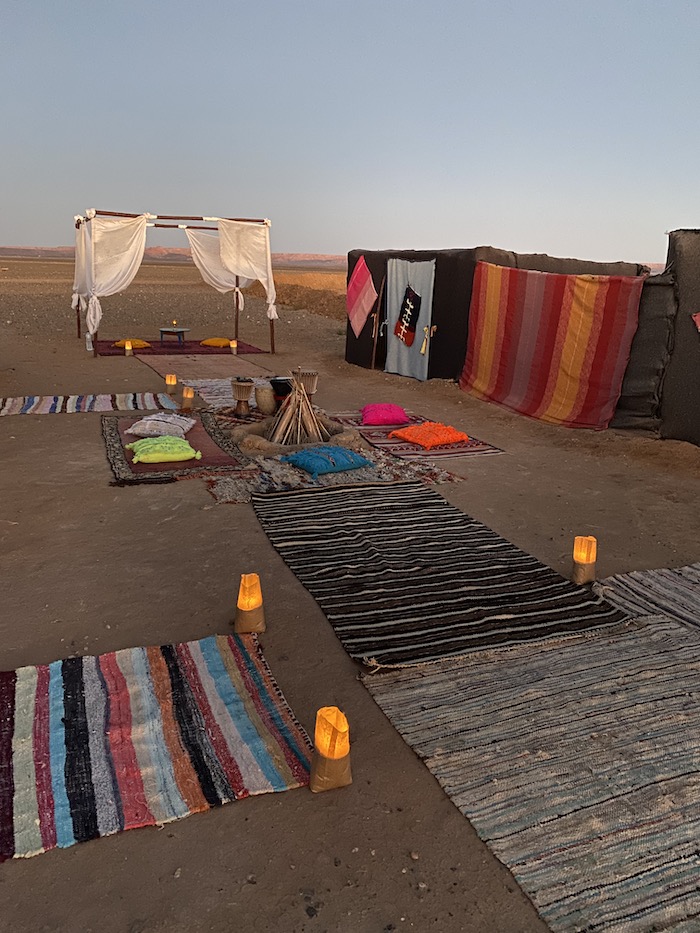
Throughout the desert, the surface is very drivable, and in this day and age, there are all sorts of vehicles coming and going and transporting anything you can imagine. There are a few defined roads, but really, you can pretty much drive wherever you want. To me it seemed like a quiet life out in the desert, there is a soft peacefulness about the energy out there. Time seems to stand still and people still move with the sun and navigate by the stars.
We had one incredible day out amongst the sand dunes. Hassan brought the fixings for a lunch, and found us a nice shady spot under a lone grouping of trees. We spent about 4 hours just sitting quietly, climbing the dunes, making patterns with our footrpints up and down the slopes, taking hundreds of photos, and enjoying the peacefulness and the solitude that the spot provided.

The stars in the night sky were simply amazing! I expected to see the milky way super bright and bold, but instead, once the moon went down, it was just a solid sheet of stars. I couldn’t even find one familiar constellation, the stars were so bright and so plentiful.
I asked Hassan if the Berber people believed the same as the Inuit People in Northern Canada, that the stars have moved. The Inuit claim that the sun doesn’t set in the same position, and the stars are in slightly different spots now. This suggests a confirmation of the theory that our planet has tilted on its axis slightly.
Yes, Hassan agreed, the stars were not in the same spots that they used to be. For generations and generations his people have been navigating by the stars, if there is one group of people who would know whether or not they have moved, it would certainly be a desert dweller.
Hassan said that the stars aren’t the only thing that has changed, in fact everything has changed in the desert during his 30 year lifetime. The lakes and rivers they used to have, have long since dried up, and the people are now forced to only get water via wells drilled far into the earth.
How much longer the wells will hold out, is anyones guess. But these people don’t plan for the future like we do in North America, instead they live each day as it comes, problem solve the problems directly in front of them, and just do the best they can do in each moment. They truly do live an easier and gentle life and from what we could see, they seem happy and content with what they have.
We couldn’t have asked for a more peaceful, authentic and transformational experience than what we had out there in the Sahara. My childhood fantasies of what it must feel like to ride a camel in the desert, have now been satiated. I no longer need to try and imagine how it is that people could possibly live in a place that seems so harsh and unforgiving. It truly felt like the quintessential desert experience, and we are so thankful for how it turned out.
But, we aren’t finished with the desert just yet. We made some connections while there, and it seems that there is some volunteer work for us there, if we so desire. We definitely loved it out there, and will definitely go back and stay for longer next time.


Are you looking for a unique and down to earth desert experience? Do you want to meet a local Berber family and see what life is like for these desert dwellers? Our contact in the desert will provide you with a top notch desert experience. Email me for details on how to book your trip!
Email Jill: info@artisticvoyages.com

